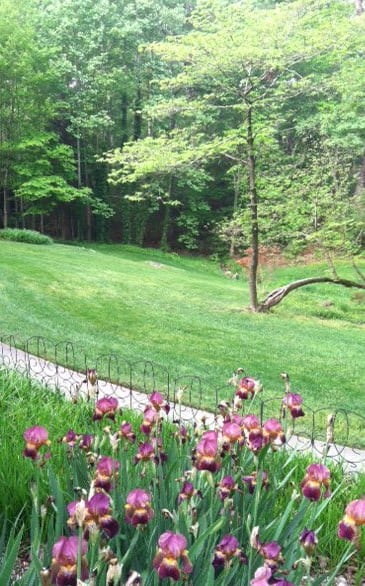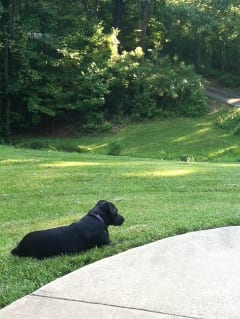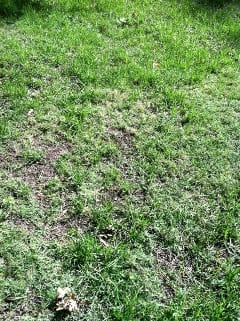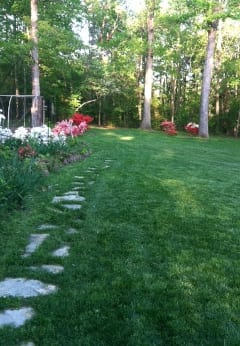by Phil Haynes
Everyone can empathize with the trauma a person must go through to withdraw from chemical dependencies, and I believe there are some real similarities with rehabilitating your lawn and soil, though not as bad as what you might see on Celebrity Rehab! Converting a lawn from traditional (chemical) care to organic care requires an ongoing discussion, and I use it as an opportunity to talk with potential and existing customers about what is actually happening with their lawns and what they can expect from me as their service provider.
Converting a lawn from traditional to chemical-free care is not for the faint of heart, and I think that’s why the “hybrid” practitioners tend to fall back on traditional methods rather than pushing through the difficulties of creating a sustainable lawn care practice. I provide a lot of education and reinforcement of key messages to ensure my customers’ success.
A Southern Perspective
But first, a little information about me. I am the owner of Clean Air Lawn Care in Charlotte, NC, and my company provides 100% chemical free (non-toxic) lawn care. We use only organic methods and products (OMRI listed) to achieve beautiful lawns. We have also developed our own actively aerated compost teas and amend them with nutrients timed to combat the stress that lawns go through seasonally.
For anyone not from the South or who has not experienced Southern culture as it pertains to lawn care, it is worth mentioning that lawn care is not just a passion down here… it is an obsession! And we’re not talking about little patches of grass on an eighth of an acre lot mostly filled by house. Our average customer has just over 7000 sq. ft. of grass, and our larger customers have more than half an acre. Many people here are curious about organic lawn care, but most are not sure they can commit to the rehab process with their lawns. Rather than compromise our values, we turn down some business and lose bids now and again, but we will not use toxins. With time and attention, ultimately, those chemicals are just not necessary.
Steps Toward Organic Conversion
If you are converting (or contemplating converting) your traditional lawn care practices to more sustainable and less toxic methods and products, there are some steps to take and some realities to consider before you take the plunge.
The first step I took was to convert my own lawn. I have 15,000 square feet of grass, and it has become the test pad for much of what we do for our customers. I began converting my lawn to become 100% chemical-free about five seasons ago. It looked just awful for the first couple of years, but is now really beautiful, deep green, and lush. I also never have to give it a second thought when the neighbor kids roll around on it with my dogs. Converting your own lawn first is a key step for anyone considering the switch – if you haven’t done it yourself, it becomes very easy to doubt your own convictions! Now that I’ve seen the “rehab” process first hand, I can speak with confidence about it, including some of the inherent frustrations (just “keeping it real”).
The second step I would recommend is to connect with as many “100%-ers” as possible. There is a growing number who have eschewed chemical fertilizers, pesticides, and herbicides. Find us on LinkedIn (ELA has a group) or Google “organic lawn care” and reach out to one or more of us directly. (Just don’t mistakenly connect with the 800-lb gorillas touting “organic-based” lawn programs that encourage customers to convert to chemicals.)
Also be aware that the “organic” lawn care industry is evolving. There are a lot of products out there that won’t give you good results… but there are a few that will do amazing things for your customers. Don’t think you have to re-invent the wheel; many practitioners are happy to tell you what works for them and what doesn’t. This is an emerging market, and there is still plenty of room for all of us to share our experience and grow our businesses.
The third to-do is to read voraciously. Many organic practitioners blog, and there are a lot of great articles and books available on the subject. In addition to reading Paul Tukey’s The Organic Lawn Care Manual to get the basics, there are quite a few other sources of good information coming from organic practitioners. Find someone in your geographic area, or look outside your area to learn how others handle weeds, reverse compacted soils, etc. Some information will be similar to traditional, but most will be amazingly different. Also, watch documentaries like One Man, One Cow, One Planet which was a huge eye opener for me.
Start Thinking Differently
The final ‘to-do’ I want to suggest is start to think differently. Challenge the status quo. As I researched and talked to dozens of providers and product sales people, I found that they practiced the same routines as they did when they applied traditional (chemical) products. The only difference was they were using less powerful products. That made no sense to me. I get that my 10-1-10 fertilizer is about half as powerful as the 28-7-14, so if I’m putting it down only once a year like the chemical guys, I’m only going to be half as effective.
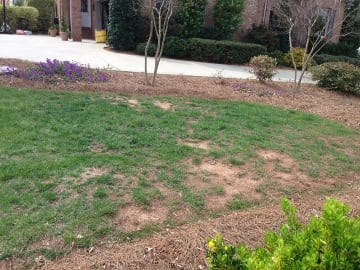
Compacted, neglected soil results in bare spots and crabgrass. Build the soil to achieve a beautiful lawn.
We’ve all heard the commercial that says, “Feed your lawn, FEED IT!” I’ve had to change my thinking around this too. If I’m being asked to help my customers grow a thick green lawn in soil that has undergone many years of neglect and abuse via traditional fertilizers, I have to re-focus my attention and give the soil enough inputs to continually achieve some level of improvement each year. I would like to rewrite that commercial to say, “Build your soil, BUILD IT!” I encourage you to be creative and experimental. Try different strategies and different products and find those that work well in your area.
Here in Charlotte, we apply 10 treatments each growing season, instead of the traditional six or seven. There are added benefits to being on a property more frequently; we can proactively scout for anything we need to react to while we get the necessary nutrients into the soil on a very regular basis. This does not make us more expensive than our chemical brethren either; through research and experimentation we’ve found ways to provide these essential inputs with competitive costs.
The Reality Checks
There are some realities to the mental shift that you need to be aware of. Some have to do with customers and some have to do with you.
- Your customers will have weeds. This really took some Zen moments for me to come to grips with and the reality has been even more difficult for many customers to accept. Most of our customers had weeds when we started, and many had chemical lawns that were devoid of any living organisms other than grass. Obviously a monoculture like a chemical lawn is not natural, so there will naturally be some weeds. I’d say that none of my
customers ever knew that specific weeds actually tell a story about specific deficiencies in the soil. To continue the rehab metaphor, remind yourself that while ‘in treatment’, your customers are bound to experience some emotion as they go through the various stages of healing their soil, and by extension, their lawns. Under a chemical fog, they have been conditioned to think of weeds as the enemy and are now being asked to embrace them as a natural part of this evolution. I’ve had to let some customers go because they demanded to be “weed-free” via chemical methods rather than take the recommended therapy… and that just isn’t what we do.
- Not everything you do with organic treatment will have a “dramatic” overnight effect. I see lawns in the spring develop that neon green after the 28-7-14 goes down, and while our lawns green up very nicely, they don’t look like the 5th hole at Augusta. Most of what we focus on is building the soil health and that takes time. Building healthy, living soil is the best way to predict a successful lawn and it requires a much more subtle approach than applying chemicals. The results are more subtle too. You have to point stuff out like, “You have lady bugs again,” “The robins have returned to your lawn because worms can now live in your soil,” or “See the grass that’s growing where it wasn’t before?” It is fun to show customers before-and-after pictures too so take a lot of them.
- Some customers will complain. I know this holds true in any service industry. You are never going to please all the people all of the time, so don’t worry when it happens. We see our job as 60% service, 40% education (through repetition, repetition, repetition). Many customers find it hard to get off the immediate gratification merry-go-round and will frequently question whether what we are doing is working. This is why it’s a great idea to convert your own lawn so you can stand strong against the “I want it now, Daddy!” mindset. Having first-hand experience has allowed me to set very real expectations on the amount of time conversion takes. Periodically reminding customers that conversion is a long-term process, not a single event, is also effective. I also email a monthly newsletter explaining what customers saw the month before, what they are seeing in the current month, and what is coming in the months ahead. Set expectations and repeat, repeat, repeat.
- Many customers are more concerned about what their neighbors think or the pressure from their Home Owner Association (HOA) than the long term health advantages to their family and pets. This one gets me every time I come up against it. Some customers will get really nervous when their HOAs, neighbors and friends see a few weeds, taller grass (all the better for growing strong roots, my dear) or a less than “golf course perfect” lawn. Under pressure, self-induced or otherwise, they will forget the reasons they chose to convert to organic lawn care: reducing childhood disease, removing the #1 cause of malignant canine lymphoma and preventing the poisoning of our water systems and wildlife. A terse letter from the HOA can override all of these important reasons. I am in the practice of reminding customers of the benefits and assuring them that what they see during the transition is only temporary. It truly gets better each month and each year. Enable them to handle the weed discussion by providing some great (non-judgmental) sound bites that will help their neighbors understand the value behind what they are working toward. No one can be forced to put toxic chemicals on their property and homeowners need to feel empowered to do what is right for them.
- You’ll feel like you’re on an island at times. The Ecological Landscape Alliance and NOFA can help you feel part of a community. When you reach out to traditional lawn care associations as an organic practitioner, you are on the outside looking in. One way I avoid isolation is by volunteering at my local community farmer’s market. There I connect with organic farmers who share my passion for sustainable land care, and we also share ideas, thoughts, and secrets (mostly them sharing secrets with me!) about how to get the job done without toxins.
Anyone can grow grass using chemicals. I mean ANYONE. It’s fool proof; just ask people who sell the stuff. They’ve even made a special spreader for you. I have a neighbor who religiously adheres to his chemical program and does exactly what the package tells him to do. This neighbor has a fluorescent green lawn 12 months out of the year with nary a weed in sight. He is a very nice neighbor, but he’s no super genius, just a guy who can follow instructions.
Alternatively, it takes courage, commitment, and a lot of education to reform your soil and grow grass organically. If you are making the switch or have made it already, you are a special breed and someone to be applauded.
About the Author
Phil Haynes owns Clean Air Lawn Care in Charlotte, NC, a company providing 100% chemical free (non-toxic) lawn care. Phil may be reached at phil@cleanairlawncare.com.

